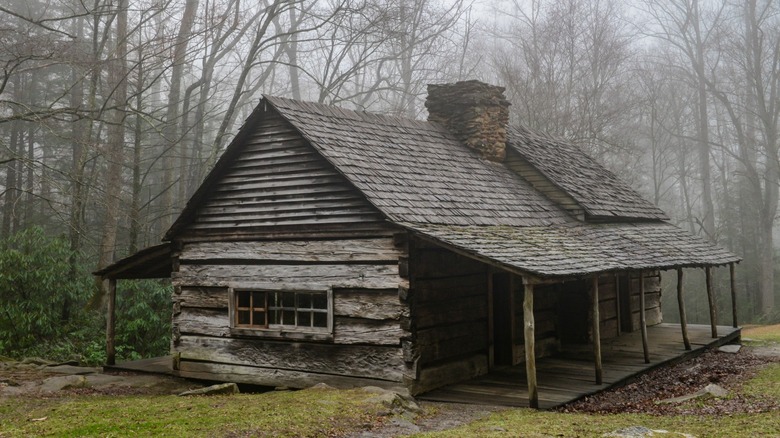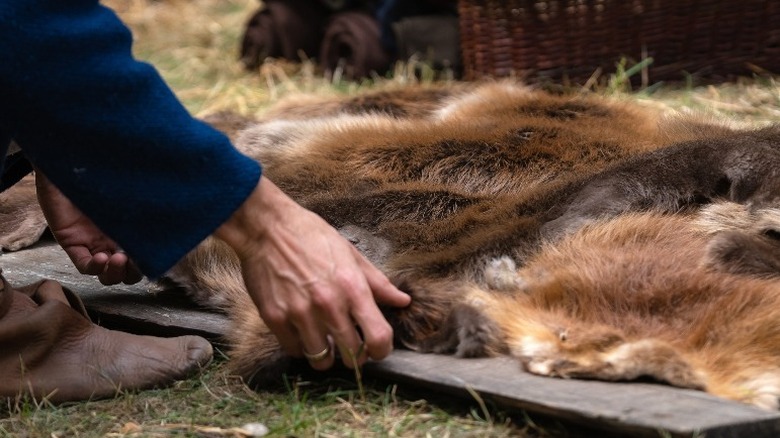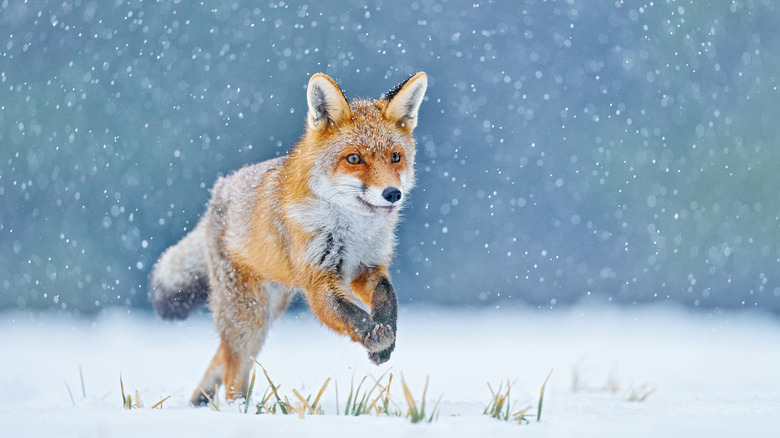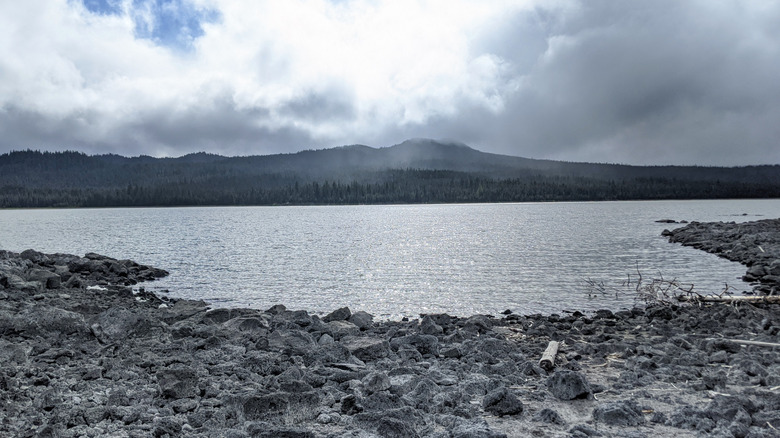The Unsolved Mystery Of The Lava Lake Murders
Lava Lake sits nestled deep in the Deschutes National Forrest, about a 45-minute drive from the town of Bend, Oregon. This picturesque location has become heavily trafficked over the years, with campers and fishermen taking advantage of all the natural beauty this part of the state has to offer (via USDA).
The lake gets its name from how it was formed. Per USDA, lava flow from millennia ago cooled and formed a damn along what would eventually become one of the lake's shores. Natural springs poured into the basin, forming a body of water that was trapped in place by cooled lava.
The cool water temperature of Lava Lake makes it a great home for trout and a wonderful destination for fishermen. But nearly a century ago, this wilderness wasn't as traversed, especially in the colder months. Hunters and trappers set up camps in the forest, earning their living while roughing it away from civilization.
One such trapping expedition in 1924 ended in the brutal murders of three men who sought refuge in the cabin that they shared. This tragic event has been known as the "Lava Lake Murders," whose perpetrator may or may not have been put behind bars.
Three trappers went into the woods but none came back out
The trapping expedition was by all accounts a success for the three men who began braving the Oregon wilderness in the fall of 1923. Edward Nickols, Dewey Morris, and Roy Wilson made plans to stay in the cabin owned by a local logging company owner, with their sights set on trapping for valuable furs beginning in the late fall and staying through the winter of 1924 (per Deschutes Pioneers Gazette).
Because of the nature of their work, the contact they had with the outside was severely limited. In those days, there were no campgrounds or hiking trails that cut around the scenic lake. So the trio was left to their own devices, cut off from the rest of civilized society while they trapped animals to sell their pelts.
Shortly before Christmas, Nickols appeared in Bend with a sled full of furs. He sold them, noting that the trapping was going well for him and his partners before heading back to the cabin.
Front Page Detectives tells of how the men were visited on January 15, 1924, by Allen Wilcoxen, the owner of a resort in Elk Lake who was snowshoeing there from his home in Fall River. Wilcoxen later reported that his three hosts were in great moods and were enjoying their successful trapping expedition. When he departed the cabin, he was the last known person to see these men alive.
A grisly discovery
When winter began to turn to spring, friends and family of the trio of trappers became concerned that they had not returned to Bend. With these concerns turning into fears about their safety, their brother of Morris reached out for help. Front Page Detectives reports that he enlisted the help of the superintendent of the Tumalo Fish Hatchery, Pearl Lynnes when he noticed that all of the traps in the area around the cabin had not been emptied. Surely if the trappers were able, they would have cleared their traps.
A search party was formed. When relatives and officials entered the cabin, they found it abandoned, but the men had left all of their possessions behind. If they had left the cabin of their own free will, they certainly wouldn't have left behind their guns, clothing, and other important items (per Tillamook Lighthead Herald).
Behind the cabin was a fox pen that contained the cabin owner's foxes. In exchange for staying in the cabin, the trappers were to feed and care for the five foxes that were contained inside it. According to Front Page Detectives, four of the foxes were found, skinned and their coats missing.
Upon investigating the grounds outside the cabin, the search party discovered several more items of interest. One was the absence of the trappers' snow sled, which appeared to have been drug away down a still visible snow trail. The other items they noticed worried them more; spent shell casings and pools of blood.
One potential suspect
The trail in the snow led to the middle of Lava Lake, where the missing sled was recovered. On the sled was more blood and clumps of what was believed to be human hair (per FrontPage Detectives). Nearby, it was detected that a hole had been chopped into the frozen lake with a hatchet. Putting the pieces together, investigators concluded that someone murdered the three trappers and deposited their bodies under the ice. But who? And why?
After the lake thawed and the three bodies were recovered, those questions loomed over the lives of the trappers' family and friends. A break in the case was made when it was discovered that Nichols had a business partner from a venture the previous summer whom he'd had a nasty falling out with. The man, Charles Kimzey, had stolen from Nichols. When confronted, Kimzey threatened Nichols, vowing to return at some point and kill him.
A traffic officer in Portland recalled that a man fitting Kimzey's description had approached him on January 25, asking for directions to a furrier. He was carrying a sack full of furs. The officer, W.C. Bender, pointed him toward Schumacher Fur Company. The proprietor made a statement claiming he bought the furs from two men, one of whom may have fit Kimzey's description and had Nichol's identification.
Kimzey was on the run for escaping prison in Idaho. He was in the middle of a 15-year sentence for burglary in Idaho when he broke out (per Tillamook Headlight Herald).
Putting Kimsey behind bars
It would be eight or nine years before Kimzey was apprehended and questioned. While in Kalispell, Montana, Kimzey was recognized by a prison guard who remembered him. Kimzey was subsequently arrested (via Tillamook Headlight Herald). He gave an alibi for the murders in Lava Lake and probably thought that the worst that could happen to him was being returned to Idaho to finish out his sentence.
But Kimzey was met with a surprise. Not long before the Lava Lake murders, he attacked a cab driver and deposited his body in a nearby well. His victim, W.O. Harrison, was not dead like Kimzey thought. He managed to climb out of the well and get help, unbeknownst to Kimzey. When the cab driver identified Kimzey as his would-be assailant, Kimzey was charged with attempted murder. He fled from the charges and remained on the run for several years before being recognized.
Law enforcement knew that Kimzey's alibi might be enough to set him free, so they took a chance and reached out to Harrison. Even though it was a decade before, Harrison was still able to identify Kimzey as his attacker. This was enough to get him charged with attempted murder.
A jury found Kimzey guilty, and he was sentenced to life in an Oregon prison. Released in 1957, he served 25 years for the attempted murder of Harrison. Unable to formally link him to the murders of the three trappers, perhaps there was some satisfaction in having him behind bars for a separate crime that he almost got away with.
The murders are officially still unsolved
The Lava Lake Murders are still officially unsolved, though the law enforcement teams of yesterday and most armchair detectives of today believe that the perpetrator was Kimzey. But even with the amount of certainty that many hold about that hypothesis, it still begs one important question; who was the second man with Kimzey when he sold the furs?
The brutal way in which Nichols, Morris, and Wilson were murdered was thought to have taken more than one person. Nichols had suffered a blast from a shotgun to his chest and face, killing him. Wilson, too, had been shot by this weapon, the buckshot entering his shoulder. He was killed by a single shot to the head from a pistol. Morris was bludgeoned to death (per Tillamook Headlight Herald).
The size of the trappers, the fact that there were three of them, and the revelation that Wilson was a former Marine made investigators doubtful that only one person could have carried out the triple murder, especially in the way it was done. The accomplice was never revealed and no one of interest was ever detained or questioned. As Kimzey flatly denied any part of the murders at Lava Lake, there wasn't any chance he was going to divulge that vital missing piece of this case.





